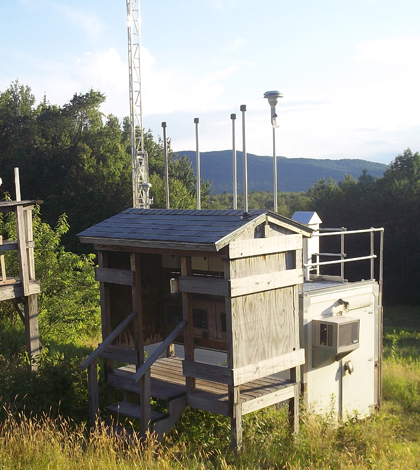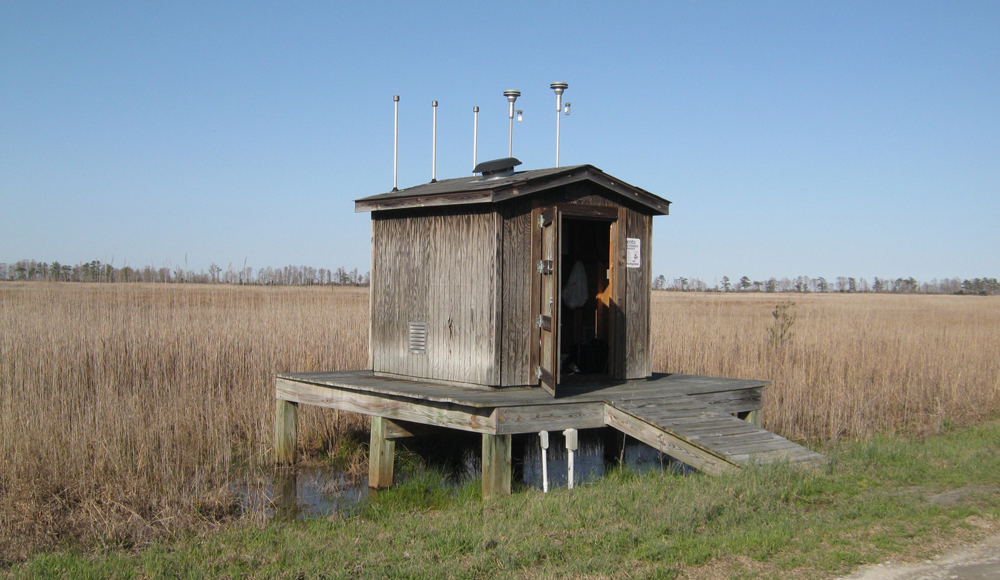IMPROVE air quality monitoring network tracks visibility in National Parks

An IMPROVE air quality monitoring station at the Proctor Maple Research Facility in Vermont (Credit: IMPROVE)
The IMPROVE air monitoring program has been tracking national trends in visual air quality for nearly three decades. The Interagency Monitoring of Protected Visual Environments network was created by the Clean Air Act to remediate poor visibility and prevent future impairment in designated areas, chiefly national parks.
Now up to 165 sites, the program’s managers are working to better the air quality samplers they use. The identical samplers are designed at Crocker Nuclear Laboratory on the campus of University of California at Davis, where the sampling network is managed. The controller units on the current models sometimes malfunction, and IMPROVE managers want to utilize advancements in digital technology and data transmission technology by implementing cellular or other types of telemetry.
“We hope to deploy a new sampler controller in a year or two. The last one was designed in the late 1990s, almost 15 years ago,” said Chuck McDade, IMPROVE program manager. “We have cell phones now and can transmit data. That’s an overriding goal – we need to change the technology to keep up with changing times.
The need is real, given the program’s intended running period: all the way through 2064.
Samplers currently in use have higher flow rates, typically two to three times higher than those used in urban air sampling. Higher rates combine with the use of smaller filters to concentrate particulate samples and reach federally mandated detection limits.
There are four modules in each sampler. The first one samples PM10 particles, while the last three sample PM2.5 particles. The PM10 module uses a Teflon filter. It is weighed, with no other analysis performed because PM10 is less important for visibility than the smaller PM2.5 particles.
“Smaller particles scatter light most effectively,” said McDade. “And the same particles can be breathed, or inhaled, all the way into the lungs.”
The last three modules track the smaller PM2.5 particles using different configurations. The first uses a Teflon filter to collect a sample, the gravimetric mass of which is recorded. These samples are analyzed using X-ray fluorescence to quantify 24 different elements. The second module uses a nylon filter for ion chromatography to quantify nitrate, nitrite, sulfate and chloride ions. The final PM2.5 module uses a quartz filter to collect samples for organic and elemental carbon analysis.
“Since we measure in really clean areas, we have to have good analysis techniques to measure what we’ve collected,” said McDade. X-ray fluorescence allows the determination of small amounts of the elements of interest in visibility assessment. When excited, each element emits characteristic x-rays that allow its concentration to be quantified.

An IMPROVE air quality monitoring station in Swanquarter, N.C. (Credit: IMPROVE)
Improving analysis techniques and sampler function is important to maintaining the network over the long term, says McDade. The enhancements will ensure reliable data collection and adherence to federal air quality standards.
IMPROVE recently established its first site outside of North America, on South Korea’s Baengnyeong Island.
“The government of South Korea was interested because the site lies along a line between Beijing and Seoul,” said McDade. “In order to understand what their own emissions contribute, they need to understand the background. Much of the airborne particulate matter that comes into Seoul comes from China.”
Ahead of installing the new site, South Korea requested that it have the same configuration as an air sampler site would in the United States. Apart from a few different plugs that had to be adapted to function with the South Korean energy grid, McDade says the site meets that request. It is the same as a U.S. site, and all its data are submitted to the IMPROVE network like any other site.
Local operators near each site, in North America and South Korea, collect filter samples which are processed in Davis. Samples have been collected by park rangers, firefighters or even local ranchers. The IMPROVE network trains each operator on sample collection and necessary routine maintenance. Following laboratory analysis, the data undergo careful data validation in Davis to ensure the accuracy of the final product. The ambient concentration data are then sent to a National Park Service facility in Ft. Collins, Colo. that maintains the data and a website to display them.
“Our role is making the measurements, understanding the measurements and making them better,” said McDade. “They’re our data and we like to pay attention.”





0 comments